12 Interesting Facts About Neptune: What the Ancients Didn’t Know
27th Dec 2022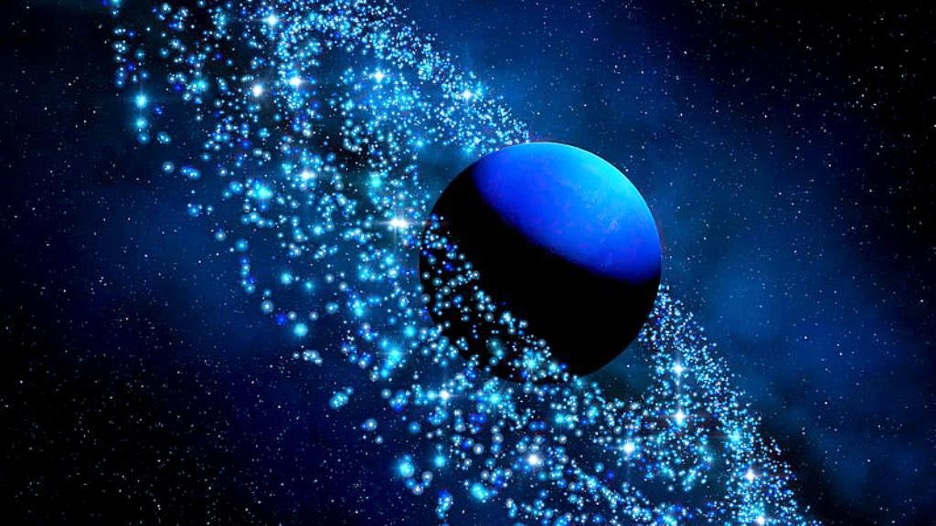
People have been interested in the starry sky since time immemorial, but they began to discover facts about Neptune, one of the most distant planets in the solar system, only in the 17th century, with the invention of the first telescopes. Neptune is the eighth and farthest planet from the Sun, and our knowledge of it is comparatively low. The planet is located too far from Earth, so manned expeditions to Neptune are not yet planned. But scientists have uncovered some information about it. Here, we list some interesting facts about Neptune, which should give you an idea of this amazing and mysterious planet.
ТОP Fun Facts about Neptune
These 12 short and interesting and fun facts about Neptune will give you an idea of this amazing and mysterious planet.
Neptune does not have a solid surface
This is one of the four planets of the outer group of the solar system, which are called gas giants. Their distinguishing feature is the absence of a solid surface, unlike the planets of the terrestrial group. Immediately behind the core and mantle of Neptune, layers of the atmosphere begin, consisting mainly of hydrogen, helium, and methane.
Neptune was found through mathematical calculations
Due to its great distance, the planet could not be identified through a telescope for a long time. And only in 1846 the French mathematician and astronomer Urbain Le Verrier made mathematical calculations that made it possible to establish the planet’s location in the starry sky.
Neptune is named after the Roman god of the seas and streams
The reason behind the planet’s name was its predominantly blue colour, as well as the tradition of using the names of ancient Roman gods to designate planets. The astronomical symbol is a stylised version of Neptune’s trident. In Greek mythology, Neptune corresponds to the god of the seas, Poseidon.
Neptune could have been given a different name
Urbain Le Verrier wanted to name the planet after himself, while its official discoverer, the German astronomer Johann Galle, leaned towards the name Janus. English astronomers argued for the name Ocean.
A year on Neptune is much longer than the Earth’s year
A year on Neptune lasts 165 Earth years. This is how long it takes the planet to make one revolution around the Sun, that’s pretty impressive, isn’t it?
Neptune has a change of seasons
The phenomenon is due to the tilt of Neptune’s axis of rotation relative to its orbital plane around the Sun. When one of the poles is tilted towards the Sun, it receives more solar radiation, which leads to “summer” on this half of the planet. At the same time, “winter” arrives on the other side. Due to its great distance from the Sun and its elongated orbit, seasons on this planet last an average of 40 years.
Neptune has been visited only once
For all the time of space flights, only one automatic NASA spacecraft, Voyager-2, was able to approach and circle the planet once. The device passed three thousand kilometres from the pole, but scientists received data on the satellites and rings of the planet.
It took 12 years for Voyager-2 to reach Neptune
Voyager-2 was launched by NASA on August 20, 1977, and successfully reached the vicinity of the planet on August 25, 1989, covering a distance of approximately 4.3 billion km (2.7 billion miles).
Neptune has the fastest winds in the solar system
The maximum speed of the Neptunian wind reaches 2400 km/h. This is about twice the speed of sound on Earth.
Neptune whistles
As Voyager 2 flew past Neptune and its moons, it registered various radio pulses that were interpreted as “whistles”. These radio pulses are associated with the interaction of the planet’s magnetic field and charged particles in its atmosphere.
Neptune has lost almost all of its moons
Today, scientists know about 14 moons of Neptune, and only one of them is really large — Triton. Triton is moving in a retrograde orbit, indicating that it has been captured by the planet’s gravity from the outside. Scientists believe that the capture of Triton led to the destruction of Neptune’s many other moons, but a grim fate awaits this satellite as well. Observations show that it is gradually approaching the planet, and eventually, the planet’s gravity will tear it apart.
What Zodiac is Neptune?
In astrology, Neptune is associated with the sign Pisces. Pisces is the twelfth and final sign of the Zodiac, represented by the symbol of two fish swimming in opposite directions. People born under the sign of Pisces are often described as compassionate, imaginative, intuitive, and sensitive. So, what is Neptune good for? It is believed that the connection of the gas giant with Pisces enhances these qualities and leads to increased spirituality and creative abilities.
And now, let’s look at these and some other fun facts about the planet Neptune in more detail.
Who and when discovered Neptune
Neptune was first “seen” through a telescope by Galileo Galilei in 1612, but he failed to recognize it as a planet. Since Neptune was at a fixed point during this observation period, its movement was minuscule, and Galileo mistook it for a star. The thing is, consistent observation of such a distant object requires a telescope with at least 200x magnification. For a long time, scientists did not have such equipment, so they used a mathematical analysis of astronomical observations to discover this celestial body. This is a unique case in history and one of the most interesting facts about Neptune.
Who used mathematical calculations to discover the planet Neptune?
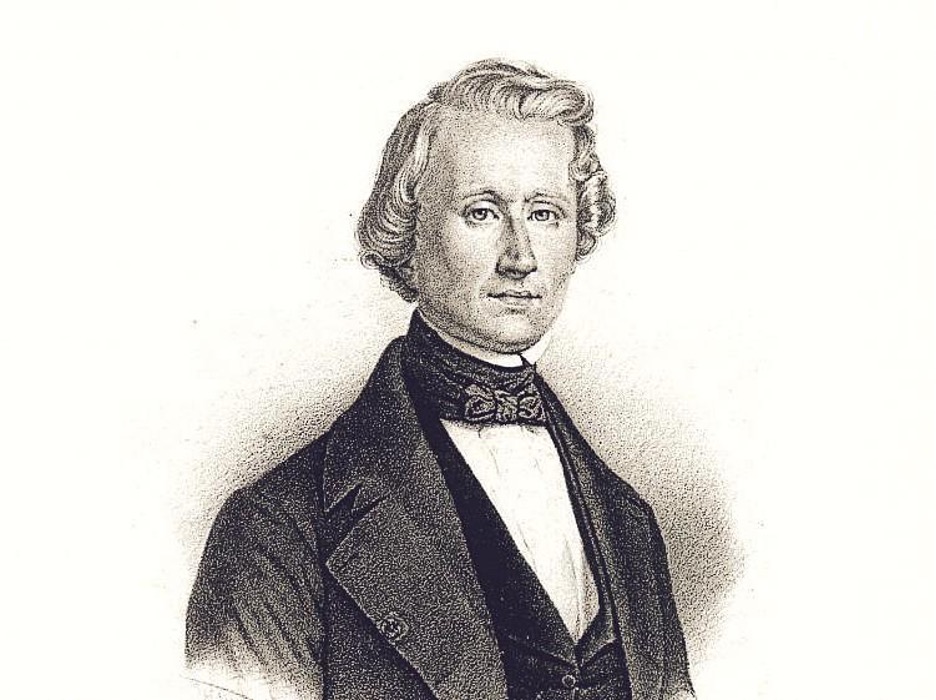
In the early 19th century, scientists were puzzled by anomalies in the orbit of Uranus and suggested that the influence of some large celestial body caused them. The French mathematician Urbain Le Verrier made mathematical calculations and convinced the German astronomer Johann Galle to start looking for this body. So on September 24, 1846, the new planet was discovered at the Berlin Observatory, which was named after the ancient Roman god of the seas and streams — Neptune. The method used in its discovery also gave Neptune its middle name — the mathematician’s planet.
The smallest gas giant
Neptune is the smallest and densest of the four gas giants in our solar system. It is located at a distance of about 4.5 billion km from the Earth (about 30 times farther from the Sun than we are). The equatorial radius is almost four times greater than the Earth’s (about 24.7 thousand km), the mass is seventeen times, the magnetic field is 27 times, and gravity is 17% higher. The planet’s rotation speed is almost twice that of Earth’s. The atmosphere consists mainly of hydrogen, helium, a small amount of ethane, hydrogen deuteride, and possibly, nitrogen.
Among interesting facts about Neptune, it is worth noting that it is the only giant planet where the shadows of upper clouds are visible on the lower cloud layers.
Neptune is blue
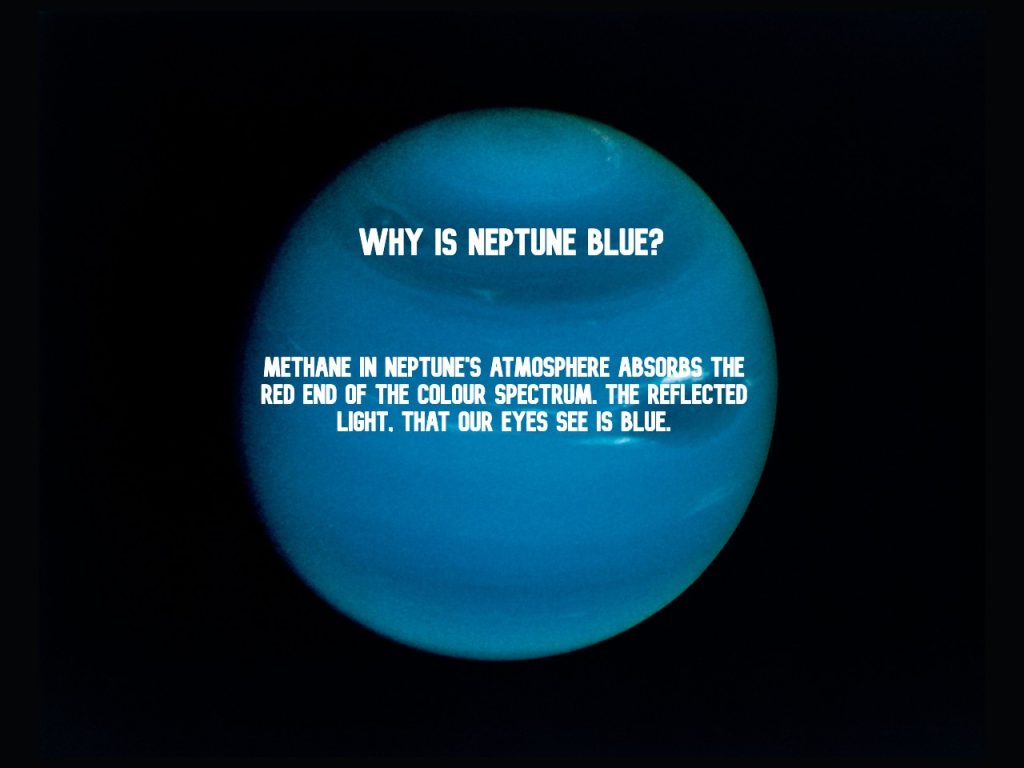
If you observe Neptune through a powerful telescope, it will appear bright blue. Astronomers believe that this colour comes from methane, which absorbs short-wave red light well and reflects long-wave light. One possible answer to the question of Why is Neptune blue is that its icy clouds may include other gases or some completely unknown components. What we do know for sure is that this colour does not come from water. Water is available in very scarce amounts on Neptune.
Cold outside, hot inside
Due to the high proportion of ice on the surface, this planet is often called the “ice giant”. However, one of the most interesting facts about Neptune is that it heats up from the inside. The temperature in the upper layers of the atmosphere is close to -220 °C, but reactions occur in the centre that heat its core up to 7000 °C. That is why Neptune radiates 2.6 times more heat than it receives from the outside.
Scientists have not been able to explain this phenomenon yet. Possibly, the heating results from the interaction of the atmosphere with ions moving in the planet’s magnetic field or is a consequence of gravitational waves from the inner regions.
Neptune has 6 rings
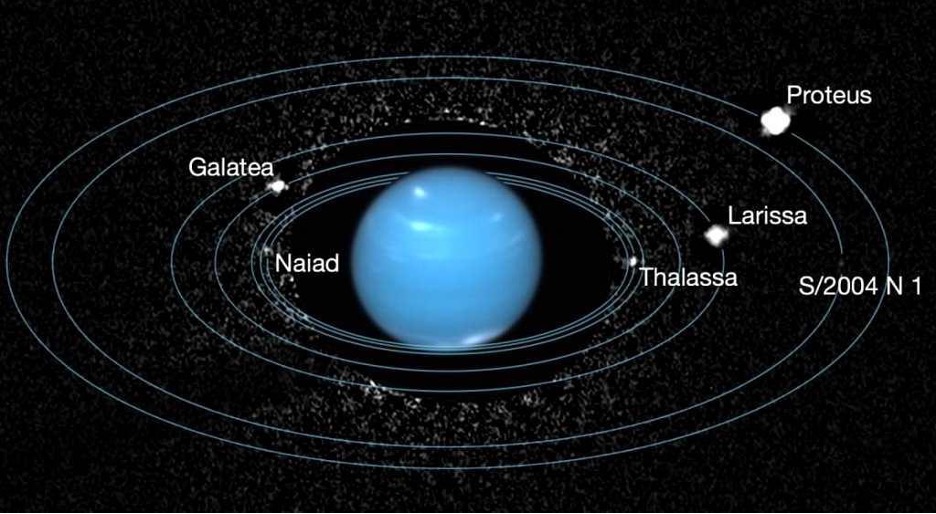
Neptune has six rings made up of frozen water and carbon. Since they are not very dense, they were only discovered in the mid-1980s. Scientists believe that these are the remains of an exploded satellite. There is an assumption that these rings are composed of dust and organic compounds formed under the influence of sunlight.
Almost liquid
Scientists believe that Neptune is an icy gaseous ball with a solid core (made of nickel iron and silicates), where the pressure can reach 7 Mbar. Below the upper layers of the atmosphere, gases condense and turn into a superheated liquid ocean with temperatures up to 200-5000 K. The total mass of this area can be 10-15 Earth masses. Very high-pressure Earth experiments show that Neptune’s upper mantle could very well be an ocean of liquid carbon.
Raining diamonds
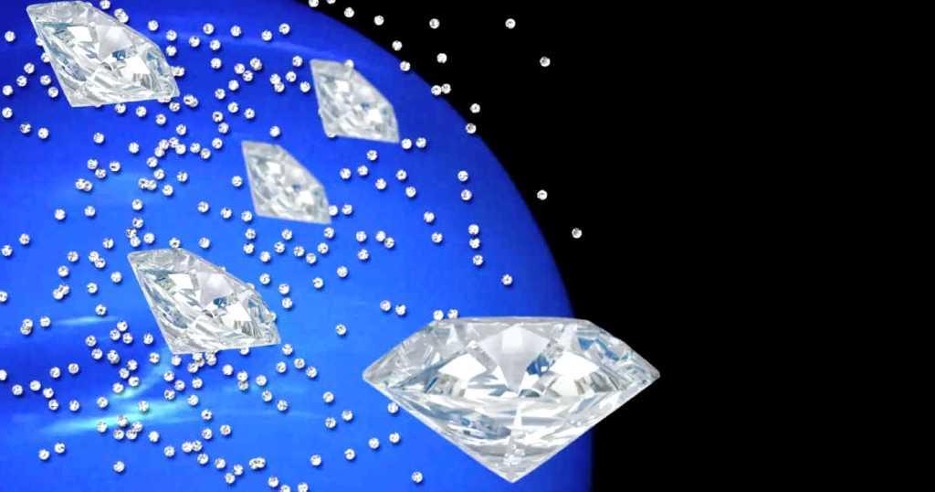
The planet’s core is covered with methane heated to 4700°C, and the pressure in the bowels at a depth of 10 thousand km can reach tens of thousands of atmospheres! This brings up the question of the possibility of converting hydrocarbons into diamonds. So, do diamonds really rain on Neptune?
Using a super-powerful X-ray laser, the researchers were able to simulate “diamond showers” in real-time. It turns out that under high pressure and temperatures, methane molecules break apart, releasing carbon, which forms crystalline patterns. Later, these diamond-like structures penetrate the layers of the heated mantle (up to 6,000°C), evaporate and rise up, so the cycle repeats again and again. Such an effect can be compared with rain. This one is most definitely in our Top 3 awesome facts about Neptune.
Giant hurricane spots

Scientists have noticed “dark spots” on the surface of the planet that appear as quickly as they disappear. Observation and study have shown that this is the shape of a huge storm system. This is what cyclones look like on Earth. On Neptune, however, they are much more powerful.
The largest cyclones on Neptune are Dark Spot and Scooter. Using the Hubble telescope, it was discovered that spots regularly appear at low altitudes of the troposphere and disappear about once every two years. The mechanism of the phenomenon is yet to be explained.
Very windy
Using images from the Voyager space probe, scientists managed to detect a hurricane in the planet’s atmosphere, with wind gusts up to 600 m/s. As a rule, at low latitudes, winds blow in the opposite direction of Neptune’s own rotation. So far, scientists cannot accurately determine the cause of this phenomenon. The only assumption is a surface effect — that is, such a wind can generate low friction cold fluid flows on the surface.
Neptune wasn’t always where it is now
Among other interesting facts about Neptune, it is worth mentioning that the planet has not always been in the orbit where it is now. Scientists believe that it could have formed closer to the Sun and then was forced into a larger orbit by the gravitational field of Jupiter.
You can’t survive on Neptune
There is nothing on Neptune that could guarantee us even the slightest chance for survival — no heat, oxygen, or water. Even for bacterial life to arise, a source of energy and liquid water is required. It is cold on the planet’s surface (the temperature is only 55 K), so assuming can life survive on Neptune is out of the question. At best, this could be possible somewhere at a depth of several kilometres. But such a possibility is still shrouded in mystery.
What would happen if Neptune exploded
So how would Neptune crush you? Scientists believe the disappearance of Neptune would likely not affect the Earth. It is too far to cause us any harm. Neighbouring Pluto will most likely be affected, while Uranus may change its orbit a little closer to Saturn; the rest of the planets should not be affected, though. However, the fact that Neptune is at the very edge of the solar system raises another danger. Scientists simulated a situation in which Neptune could be affected by a neighbouring star that came close enough to our Solar System. The simulations suggest that a passing star only needs to change Neptune’s orbit by 0.1%, a distance three times the distance between the Earth and the Sun, for all the planets in the Solar System to descend into chaos. Fortunately, this probability is minuscule, so we hardly need to worry about it.
Final thoughts
Now that you have learned the most interesting facts about Neptune, you probably have new questions in mind. You’re not alone in this!
So far, our technology is underdeveloped for exploring Neptune up close. This planet’s weather is terrible, and there is no oxygen or solid surface. We can’t even land on it, so we will have to rely on powerful telescopes and robotic missions to learn any new information about this planet. Let’s be patient, and maybe we will discover some new fun facts about Neptune soon.
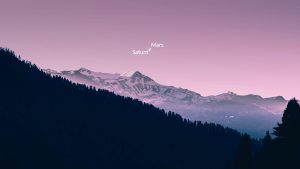

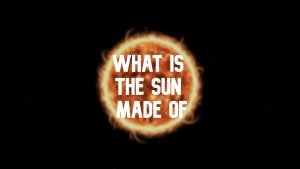



Thank you for your comment! It will be visible on the site after moderation.